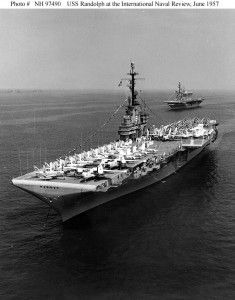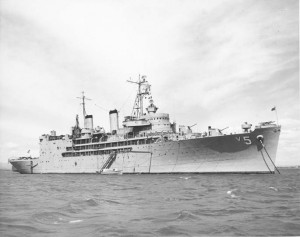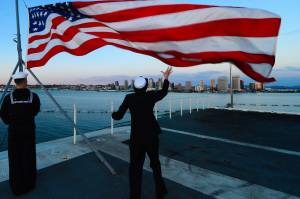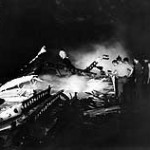My 1st ship was the USS Albemarle, I went aboard her in 1959. The Albemarle was commissioned in 1940 and served for twenty years, seeing action all during WW2. Her main purpose was to patrol the coasts conducting anti-submarine patrols with her squadrons of sea planes. The ship was capable of bringing the large seaplanes on to her fantail for repairs. She was equipped with 2 – 5 inch gun mounts, 20 and 40 mm Anti-aircraft guns. She was decommissioned in 1960 at the Philadelphia Naval Ship Yard while I was aboard.
 My second ship was the U.S.S. Randolph, CVS-15, going aboard her in 1960. The Randolph was one of 24 Essex-class aircraft carriers built during World War II for the United States Navy. The second US Navy ship to bear the name, she was named for Peyton Randolph, president of the First Continental Congress. Randolph was commissioned in October 1944, and served in several campaigns in the Pacific Theater of Operations, earning three battle stars. She was struck by a Kamikazee in 1945, killing 27 sailors and wounding 105. Decommissioned shortly after the end of the war, she was modernized and recommissioned in the early 1950s as an attack carrier (CVA), and then eventually became an antisubmarine carrier (CVS). In her second career she operated exclusively in the Atlantic, Mediterranean, and Caribbean. In the early 1960s she served as the recovery ship for two Project Mercury space missions, including John Glenn’s historic first orbital flight. I spent the remainder of my enlistment in the Randolph’s Weather Service, being discharged on February 21, 1961.
My second ship was the U.S.S. Randolph, CVS-15, going aboard her in 1960. The Randolph was one of 24 Essex-class aircraft carriers built during World War II for the United States Navy. The second US Navy ship to bear the name, she was named for Peyton Randolph, president of the First Continental Congress. Randolph was commissioned in October 1944, and served in several campaigns in the Pacific Theater of Operations, earning three battle stars. She was struck by a Kamikazee in 1945, killing 27 sailors and wounding 105. Decommissioned shortly after the end of the war, she was modernized and recommissioned in the early 1950s as an attack carrier (CVA), and then eventually became an antisubmarine carrier (CVS). In her second career she operated exclusively in the Atlantic, Mediterranean, and Caribbean. In the early 1960s she served as the recovery ship for two Project Mercury space missions, including John Glenn’s historic first orbital flight. I spent the remainder of my enlistment in the Randolph’s Weather Service, being discharged on February 21, 1961.
She was decommissioned in 1969 and sold for scrap in 1975.
- USS Albemarle, AV 5 Seaplane Tender
- Albemarle arriving at pier 7, Norfolk, Virginia
- Standing Captain’s Inspection on the Albemarle – Upper left, 2nd from rt., Aerographers Mate Roger Graves
- Enjoying liberty with fellow Weathermen at the Enlisted Men’s Club Guantanamo Bay Naval Base
- Randolph paying homage to Halifax,Nova Scotia












4 Responses to Navy Days – USS Albemarle and USS Randolph